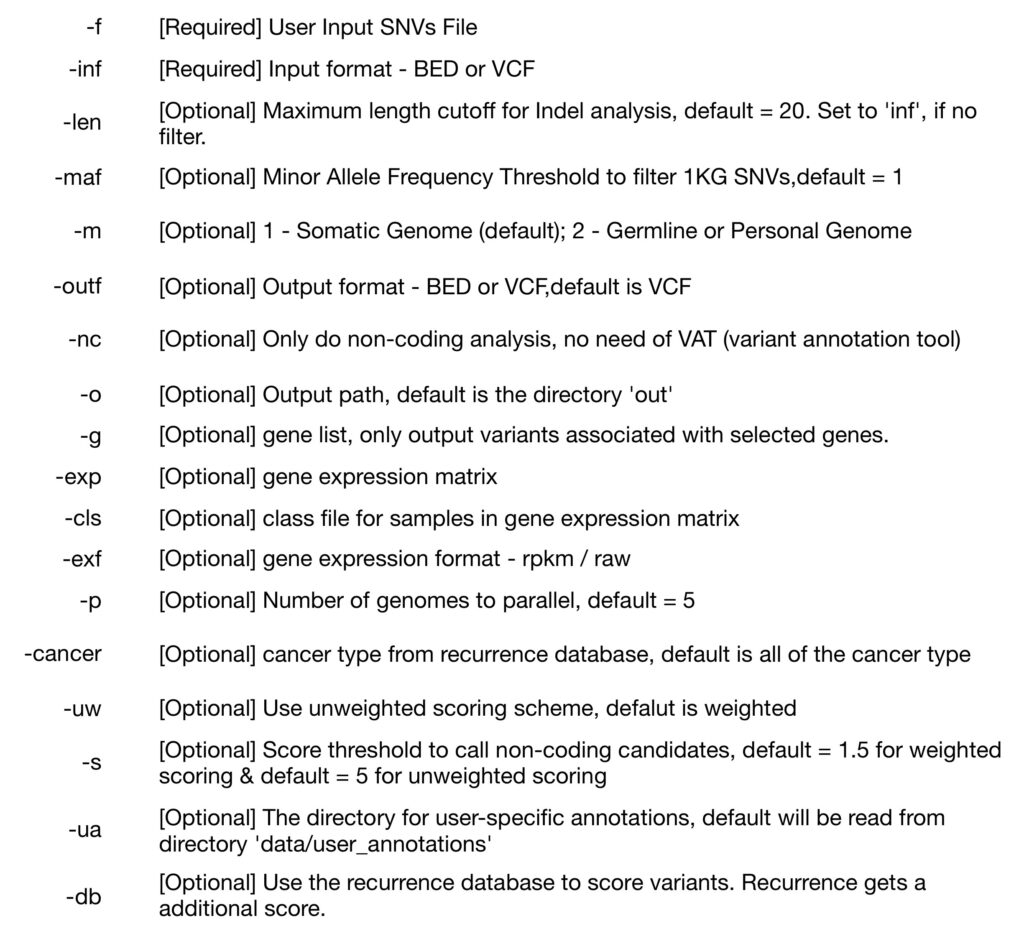Only the most essentials are kept, mostly explanation of installation errors and how to fix them. For detailed instructions, please refer to Funseq2 Protocol.
It’s recommended to install things to a designated Conda environment, for some tools, I will only list Conda installation command.
Dependances to install first
– TPMpvalue [link]
– Perl package Parallel::ForkManager [link]
– bedtools/tabix/bigwigAverageOverBed
– VAT (snpMapper, indelMapper Module) [link]
– sed/awk/grep (those should have been pre-installed already)
TPMpvalue
Download the TFM-Pvalue.tar.gz from its website, tar -xf TFM-Pvalue.tar.gz to decompress the package and cd into the folder. To compile the package type as follow.
tar -xf TFM-Pvalue.tar.gz
cd TFM-Pvalue
makeAfter compiling the tool successfully, either directly copy the compiled binary files into your /usr/bin folder, or add the path to the environmental variable as below.
export PATH=$PATH:/where/you/put/binary/filesPossible Error:
g++ -O3 -DJASPAR=1 -DPROGRAM=0 TFMpvalue.cpp Matrix.cpp ArgumentException.cpp FileException.cpp ParseException.cpp -o TFMpvalue-pv2sc
TFMpvalue.cpp: In function ‘void arguments(int, char* const*)’:
TFMpvalue.cpp:503:45: error: ‘getopt’ was not declared in this scope
Solution:
In theTFM-Pvaluefolder, find the fileTFPpvaue.cpp, uncomment line 16 in that file and changeGetOpt.hintogetopt.h.
Perl package Parallel::ForkManager
Here is the installation using Conda.
conda install -n yourEnvr -c bioconda perl-parallel-forkmanagerbedtools/tabix/bigwigAverageOverBed
Installation using Conda.
conda install -n yourEnvr -c bioconda bedtools
conda install -n yourEnvr -c bioconda tabix
conda install -n yourEnvr -c bioconda ucsc-bigwigaverageoverbedVAT
The easiest way is to download pre-built binaries, save them into your local /usr/bin/ or add the path to your environmental variable and make them executable.
export PATH=$PATH:/where/you/put/binary/files
chmod +x snpMapper
chmod +x indelMapper # <- to make them executableDownload the Funseq2 and pre-processed data
Download the Funse2 from its newest update:
https://github.com/khuranalab/FunSeq2_DC
Download the latest data needed for Funseq2 and put everything into the data_context folder, unzip XXX.tar.gz folders within data_context
https://khuranalab.med.cornell.edu/data_DC3.html
You can also download an older build of the data set from https://khuranalab.med.cornell.edu/data.html
The content can be downloaded in a compressed folder from that page.
Prepare funseq2.sh and config.txt file to run Funseq2
In your FunSeq2_DC folder, you need to modify two files before starting: funseq2.sh and contig.txt.
### In funseq2.sh ###
# keep "data_context/user_annotations" intact
user_anno=/your/destination/of/data_context/user_annotations
### In contig.txt ###
# Change the file path first and then change the annotation files you want to use accordingly.
file_path=/your/destination/of/data_contextThe destination
user_annocan be specified in the running command by using the option-ua. But if you don’t want to type that every time, you can just change it in funseq2.sh.
If running on cluster and using Conda, remember to export the $TMPDIR to $PERL5LIB
export PERL5LIB=$PERL5LIB:$TMPDIRRunning FunSeq2
After all the preparation, we are finally here. To run FunSeq2 is simple.
funseq2.sh -f file -maf MAF -m <1/2> -len length_cut -inf <bed/vcf> -outf <bed/vcf> -nc -o path -g file -exp file -cls file -exf <rpkm/raw> -p int -cancer cancer_type -s score -uw -ua user_annotations_directory -db
Source:
https://currentprotocols.onlinelibrary.wiley.com/doi/full/10.1002/cpbi.23
https://github.com/gersteinlab/FunSeq2/issues/4
http://info.gersteinlab.org/Funseq2#E._Input_files
https://anaconda.org/bioconda/perl-parallel-forkmanager
https://metacpan.org/pod/release/SZABGAB/Parallel-ForkManager-1.03/lib/Parallel/ForkManager.pm
https://anaconda.org/bioconda/bedtools
https://anaconda.org/bioconda/tabix
https://anaconda.org/bioconda/ucsc-bigwigaverageoverbed
https://github.com/khuranalab/FunSeq2_DC
https://genomebiology.biomedcentral.com/articles/10.1186/s13059-014-0480-5
https://science.sciencemag.org/content/342/6154/1235587.long